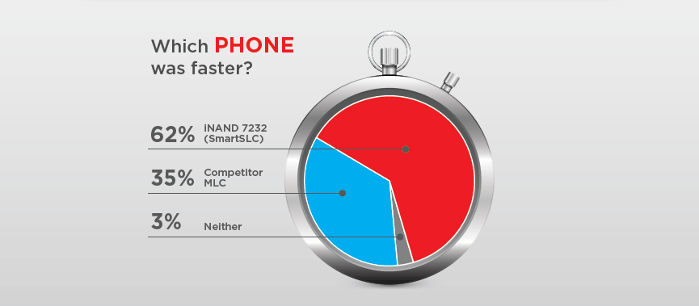Taking Storage Solutions for a Test Drive
At Mobile World Congress in Barcelona this past February we asked more than 350 people to “test drive” two different phones by trying out a number of applications on each phone. The phones were identical on the outside and we didn’t let our testers know how they were different or even if they were different. After letting the testers take each phone for a “spin,” we asked about their experiences with each phone.

In terms of performance by responsiveness:
- Only 3% of the people comparing the two phones had no opinion on the matter
- 35% thought phone A was the faster phone
- 62% thought phone B was the faster phone
So what was the difference?
- Phone B, judged faster by nearly two-thirds of our testers, was using SanDisk’s iNAND 7232 embedded storage enhanced with SmartSLC technology.
- Phone A used another storage vendor’s comparably sized storage solution with a multi-level cell (MLC) architecture.
Without knowing that critical difference, 62% of the people we asked said that the phone using what most tech-savvy people would assume to be a slower storage solution (since the iNAND 7232 solution is technically a triple-level cell—or TLC—architecture) was in fact faster than the phone built on the supposedly faster MLC storage solution.
And the differences in perceived performance were not slight. When we asked whether there was a significant performance difference between the two phones, 76% of respondents answered “yes.”
TLC vs. MLC
If TLC is considered slower than MLC, why did these users have a superior experience? The answer is twofold. First, there’s simply no significant difference in real world performance between TLC and MLC architectures today. The notion that MLC is faster is simply not true. Then there was a second differentiating factor in these two phones. The SanDisk iNAND 7232 leverages SanDisk’s SmartSLC technology, which optimizes engagement with the storage system in a wide range of use cases. With sequential writes of more than 1.2Gbs, this hardware/software combination enables photographers to capture 10-15% more photos when shooting in burst mode. Even on phones, users can capture RAW images rather than lesser-quality JPGs. They can also capture downloaded data, including 4K video, without the buffering and write throttling required in an MLC environment—which translates directly into a better user experience.
Storage manufacturers building MLC-based offerings have long commanded a price premium for the performance that MLC was believed to deliver. But the experience of these 350 individuals at Mobile World Congress suggests that this performance advantage is illusory. Indeed, when we drilled into the users’ experiences of the phones’ apps, we found noticeable performance improvements across a range of popular use cases, including:
- Maps
- Media Player
- 2D Gaming
- VR Gaming
- Photo editing
- Messaging
- Search
So think about it. Chances are you’re trying to deliver the best experience at a profitable price. The input from our Mobile World Congress testers suggests that the best path to that goal might not be via MLC-based storage solutions. TLC-based solutions, like SanDisk’s iNAND 7232 e.MMC with SmartSLC technology, can provide a smarter path towards your goal.




